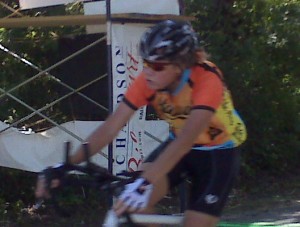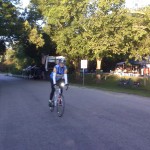Pacing, what pacing?
Things came together pretty well for me at this race. I went out “too fast” and kept up a pace I thought was “too fast” for most of the race. I had a couple of slower laps on Sunday morning. Then, as I started my final lap, hoping I could finish it off in less than 2 hours, I noticed that my legs were feeling a bit tired. I quickly forgot that and started worrying about the wind that had been picking up intensity all morning. I thought I better take advantage of the little tail wind early in the lap, and increased my effort. I’d started my last lap about 5 minutes before the 6 hour time trial. About 25 minutes into it the lead motorcycle and first rider caught me. I got continual encouragement as the 6 hour riders passed and was motivated to keep them in my sights as long as I could. Before I knew it I was “sprinting” for the finish line with a lap time of 1:38, only four minutes slower than my first lap.
Sleep is a powerful motivator
I don’t have a good plan for events that start a few hours before my bed time and I was feeling sleepy by the time the 6pm start rolled around. I learned that sleep is a good motivator for me. I promised myself three hours of sleep and a shower at the hotel if I finished the first 300 miles in less than 24 hours. It probably wasn’t good strategy for a 500 mile race, but my first objective was the 300 and the promise of sleep kept me focused for most of the first 24 hours.
I stopped for two more 45 min naps; one early Saturday morning and one early Sunday morning. Those were essential, I’m-unsafe-to-ride naps.
If you’re going to the trouble of bringing a second bike, it should really be ready to ride
When I returned from my four hour shower-nap break on Saturday night, I decided to check my tire pressure. I mentioned in my ROF report that I’ve started using tubeless road tires and for the most part I love them. However, I do not love having my valve cores unthread at 10pm on the second night of a 500 mile race…especially when I’m my own mechanic. When the valve core came loose on my back tire, it lost so much pressure that the sidewall unsealed from the rim. No amount of hand pumping was going to reseat the tire. I got the tire reseated with a CO2 cartridge, but then wasn’t confident of it holding air so I decided to take my old Vitus that I’d brought with fenders installed in case of rain. I took off the fenders and started moving lights over. As I was about finished I saw my “rain saddle” and cringed. By this time the tire on my RS had been holding air for close to 30 minutes so I moved everything back and just went out on it with a few extra CO2 cartridges in my jersey pockets. I’d been swinging my leg over my saddle saying, “see ya in a while,” when I decided to check the air pressure…45 minutes later I actually left for Lap 13.
Amazing volunteers
The Texas Time Trials had an amazing number of supportive, enthusiastic, cheering volunteers out on the course. Before the first lap was finished I was dumbfounded by the contribution these cyclists and cycling supporters were making to the event. At every major intersection there were volunteers pointing the way, checking traffic, and warning riders about road hazards. The volunteers’ enthusiasm was matched by the Race Director, Dan Driscoll. He made all the riders feel like their race was successful and their efforts appreciated.
The course was well marked. No route sheets or maps needed. There were reflective arrows painted on the road at turns, road hazards and large potholes were marked, there were also lots of blinking lights at all intersections. Comparing the road at the end of the race to the road on Thursday and Friday it appeared that a lot of time had been spent clearing road kill and gravel from the road fairly close to the Thursday, 6pm start time.
Besides the volunteers manning the intersections and timing table, there were also a number of people in vehicles and on motorcycles constantly sweeping the course. Though riders weren’t allowed crew on the course, a rider shouldn’t have had to wait more than 15-20 minutes if they had a problem. It was reassuring when I went out on my questionable tire to know that there were people checking the course regularly.

